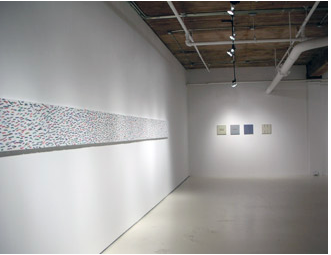LINES 2007

Stitched Lines (2007)acrylic & thread on canvas, 93.4” x 84”

Black& White Series, oil pastel. oil stick on paper, 11” x 11”

Colours on White (2007) acrylic on wood, 11” x 11”

White on Black (1988) oil stick, oil pastel on paper, 11” x 11”,
2400 Routered Lines (2007), acrylic on wood,14” x 252”,
Rouleau Lines (2007) cotton and acrylic on canvas, 16’ X16”

2400 Routered Lines (2007, alternate arrangement) acrylic on wood, 84” x 58”

Four Tabs (a), (2003) oil stick & oil pastel on paper, 11” x 11”

Four Tabs (b), (2003) oil stick & oil pastel on paper, 11” x 11”

Four Tabs (c), (2003) oil stick & oil pastel on paper, 11” x 11”

Four Tabs (d), (2003) oil stick & oil pastel on paper, 11” x 11”

Two Lines, (2007) acrylic on wood, 11” x 11”

Four Lines, (2007) acrylic on wood, 11” x 11”

One Line, (2007) acrylic on wood, 11” x 11”

Many Short Lines on Brown, (2007) acrylic on wood, 11” x 11”

26 Rust 1.25" Lines, (2007) acrylic on wood, 11” x 11”

26 Dark 1.25" Lines, (2007) acrylic on wood, 11” x 11”

Black Clockwise Lines (2007) acrylic on wood, 11” x 11”

Random Short Lines, (2007) acrylic on wood, 11” x 11”

44 Verticals (1), (2007) acrylic on wood, 11” x 11”

Black on White, (2007) acrylic on wood, 11” x 11”

2" Arrange Vertical Lines (2007), acrylic on wood, 11” x 11”
G Getting stuck is nothing new. It happens. Normally I would just make more black and white drawings until I had worked my way through the bad patch. However, this time, because of that 2D/3D dialogue, I decided to make 11” x 11” reliefs instead. The scale and format were the same but the surfaces and media were changed. I moved to lines because, frankly, I’d had enough of circles for a while. When I draw lines I go right back to childhood and drawing black marks on white paper. As a kid I liked the power of it. As an adult I know that black marks on white (or white marks on black), especially repeated marks, generate intense optical activity: flashing and after images. Judicious use of complementary colours will do the same thing. It is this knowledge that has governed the palette for the work. I have been playing with value contrasts and grayed complements throughout.
S Sticking with just lines as a thematic device created room for me to experiment with scale and different ways of creating relief surfaces. The large canvas tarpaulin-like work was pre painted then stitched on a sewing machine. I wanted to acknowledge the fact that canvas is a fabric by getting it off the stretcher. The sewing is a connecting device within the work from front to back. There is work that has been routered and companion work that has raised stitched areas. I traced the routers to get the design for the stitching. All the lines on the small wooden pieces were cut from coffee shop stir sticks and glued to plywood which is itself joined with glue.
I I would like to thank my niece Adrienne Little for giving up her days off to assist me in sewing the tarpaulins. I could not have finished them without her help.


